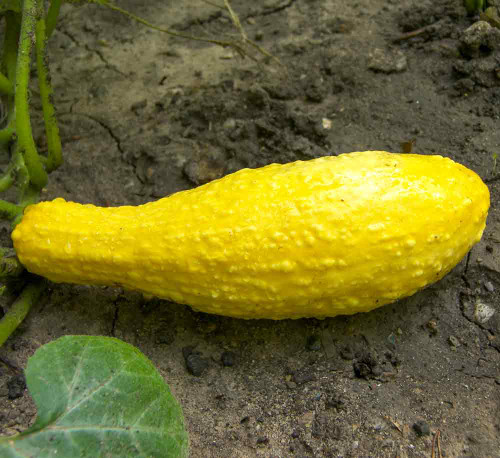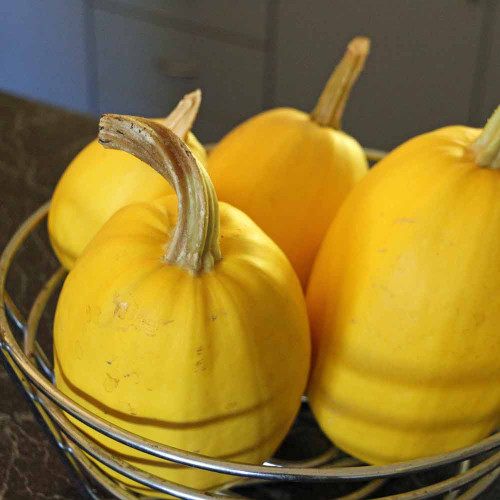Description
Zappallo de Tronco Squash - The Avocado Squash
Zappallo de Tronco squash is a beloved staple and highly sought-after variety from Argentina. Rare and unusual in the US, it is a C maxima type so it doesn't attract squash bugs and vine borers like the more common C pepo variety.
The young round fruit is glossy dark green with a very tender skin protecting light green meaty flesh that looks similar to a Hass avocado, thus giving it the name of avocado squash.
The flesh is very smooth and dry with a deliciously rich and buttery flavor - much preferred to the usual summer squash or zucchini. As a summer squash, it is never watery like most other zucchini types.
Argentinian ex-pats or people who experienced this squash in South America hunt down seed sources almost obsessively because of the unforgettable flavor.
When we sell out, we always have a waiting list eager to be notified as soon as it is back in stock!
It is known by several names, including Zapallo, Zappallos, zapallito relleno, Zapallitos de tronco, Zapallitos Redondos, Redondo de Tronco, Zapallo del Tronco, Argentina Squash, Peruvian Squash, Chilean Squash, and Inca Squash.
Details
This compact, semi-bush variety is highly productive - one plant can often produce enough fruit to supply a family of two with delicious fruit throughout the summer.
Zappallo grows like a wonderful cross between a summer and winter squash when young and small with an edible rind and a winter squash once it matures and the rind hardens. The flavor is noticeably richer and more flavorful than the standard summer zucchini.
Fruit is set along on the stalk, keeping the fruit off of the ground and avoiding most squash bug infestations and ground-rot problems.
We've noticed that once a leaf or fruit of a squash touches the ground, squash bugs seem to appear with a couple of days.
Does well in a large container at least 18" in diameter and a foot deep.
Can be eaten whole when small (2½-4") as summer squash or left to mature to the fully ribbed state and used as winter squash. It is never bitter, even when picked fully mature with ribs showing. A bushy upright plant with 3-4" acorn type squash with great texture and flavor. Drought-tolerant and quick maturing.
As a winter squash, it has the dry, semi-sweet flesh like a pumpkin, but is a relatively short keeper. Unlike its pumpkin relatives, it is frost-sensitive. Mature fruit is very dark muted green which usually turns orange in storage, with sweet orange flesh which makes a great soup.
History
Originally from Argentina where it is a beloved staple and easily found at markets, this variety does well in American gardens where almost all other squash fail. This would be an excellent squash to have in major circulation.
Summer Squash is one of the oldest known crops-it was found in 10,000-year-old archaeological sites in Mexico. Its cultivation in the southern and eastern U.S. and some highlands of Central America dates back to at least 2700 BC. The remarkable diversity was already present in pre-Columbian times.
Uses
Zappallo is most often used fresh - grilled, cooked in soups, or even used in pies. It is very versatile in the kitchen as the flesh is sturdy enough to stand up to olive oil and fresh minced garlic without being overpowered by it, yet it softens nicely when sautéed.
Grilling opens up new ways to use it with new flavors, turning easily over the flame with either tongs or a spatula without falling apart.
A simple yet delicious way to grill it is to lightly drizzle olive oil and sprinkle sea salt over each side of a thick slice, then grill on medium heat - either indirect or direct for a couple of minutes. Turn after a couple of minutes, grilling to your preferred softness.
Growing Tip
Squash are heavy feeders and love growing in fertile soil that has been amended with well-aged compost. Dig the compost into the soil about 6-8" deep prior to planting seeds.
All squash dislike cold soil - 70°F is the minimum temperature to plant, and 80°-90°F is ideal, giving you faster and better seed germination. Use a kitchen thermometer to read the soil about 1-2" deep early in the morning. You are looking to find the lowest soil temperature for the day, as this is the most limiting factor for seed germination. You can also use the back of your hand to feel the soil - if it feels cold to your hand, it is too cold to plant seeds!
Sow 4-5 seeds per cluster, about 1/4" deep in moist soil, 4' apart. Once the seedlings are a few inches tall, thin to the 2-3 biggest and most healthy-looking plants. Use scissors or pruning shears to thin, never pull seedlings out as that seriously disrupts the remaining roots and will significantly affect the growth and production of the remaining plants.
Harvest Tip
If using as summer squash, harvest every day or two to encourage continued production, when the fruit are 4-6" in diameter. Do not pull or twist the fruit from the stem, use a sharp knife or pruning shears to cleanly cut the stem, making sure it doesn't contact the soil which attracts squash bugs and vine borers. Use a small square of cardboard or folded newspaper under the cut stem on the plant if needed.
If using as winter squash, let the fruit mature. The skin will harden and develop ridges while turning a deep matte green. The stem will begin to harden. Harvest when the skin is firm and resists denting by your fingernail when pressed. The stem should be hard but may not be completely dry with the Zappallo variety. Cut cleanly with a sharp knife or pruning shears, wipe the skin clean with a barely damp cloth, and store in a cool, dry place.
Check often for any soft spots and use those first after cutting the soft spots out. It is a short keeper, usually 2-3 months in good conditions.
Learn More
From the soil to the seed to the food you eat - we'll help you grow your best garden!
3 Reviews
-
Such good flavor!
I planted late, but still got fairly good harvest, with more coming when frost hit. Nutty, flavorful, doesn't get mushy like zucchini, but creamy. The Maxima (one website said) don't attract squash bugs the way pepo's do - I had no bugs on these, but many many on the Lady Godiva winter squash.
-
Excellent!
Grew one plant in small garden in north Willamette Valley, Oregon. It sprawled in a lively and lovely fashion and produced absolutely delicious summer squash. My new fave! It’s a must-plant, along with heirloom crookneck squash.
-
Zapallo de Tronco squash
Every friend i've shared this squash with over a number of years has loved it. I've found squash bugs are not quickly killing it, and although it produces well, it's not overwhelming like zucchini. One friend who tasted it (lightly sauteed) who claimed to be a connoisseur of summer squash, said his "tongue had an orgasm" when he tasted it.














